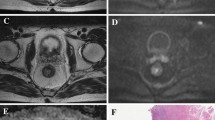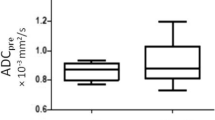Abstract
Purpose
This study evaluated the feasibility of magnetic resonance (MR) volumetry using a diffusion-weighted data set (VDWI) and compared it with conventional T2-weighted volumetry (VC) in patients affected by rectal cancer treated with chemoradiation therapy (CHRT).
Materials and methods
Fourteen patients with a biopsy diagnosis of rectal cancer underwent MR examination before and after CHRT. T2-weighted images were used to extrapolate VC. A diffusion-weighted (DW) sequence was acquired [spin-echo diffusion-weighted echo-planar imaging (SE-DW-EPI)] with a b-value of 800 s/mm2 and volume (VDWI) was calculated by semiautomatic segmentation of tumour hyperintensity. Two radiologists independently assessed volumes and analysed data in order to establish interobserver agreement and compare and correlate volumes to tumour regression grade (TRG), as evaluable at pathological examination of the surgical specimen.
Results
Interobserver agreement was 0.977 [(95% confidence interval (CI) 0.954–0.989) and 0.956 (95% CI 0.905–0.980) for VC and VDWI and 0.964 (95% CI 0.896–0.988) and 0.271 (95% CI-0.267 to 0.686) between VC and VDWI before and after CHRT. The correlation between TRG and VC and VDWI was, respectively, rho = 0.597 (p<0.05) and r2=0.156 (p=0.162) and rho=0.847 (p<0.001).
Conclusions
VDWI seems to be a promising tool for assessing response to CHRT in rectal cancer. Further studies on large series of patients are needed to refine the technique and evaluate its potential predictive value.
Riassunto
Obiettivo
Scopo del nostro lavoro è stato valutare la fattibilità della volumetria in risonanza magnetica (RM) con immagini pesate in diffusione (VDWI) e confrontare tale metodo con la volumetria convenzionale (VC) basata su immagini T2-pesate in pazienti affetti da neoplasia rettale trattati con chemio-radioterapia (CHRT).
Materiali e metodi
Quattordici pazienti affetti da neoplasia rettale documentata istologicamente sono stati esaminati con RM prima e dopo chemio-radioterapia. Due osservatori hanno estrapolato indipendentemente il VC dalle immagini T2-pesate e il VDWI dall’acquisizione spin echo (SE)-echo-planar imaging (EPI)-diffusion-weighted (DW) (b-value 800 s/mm2) mediante segmentazione semiautomatica dell’iperintensità patologica. Le due volumetrie sono state comparate e correlate al grado di regressione tumorale sul pezzo operatorio (tumor regression grade, TRG).
Risultati
L’accordo inter-osservatore per VC e VDWI è stato di 0,977 (95% intervallo di confidenza 0,954–0,989) e 0,956 (95% intervallo di confidenza 0,905–0,980) e tra VC e VDWI pre- e post-CHRT di 0,964 (95% intervallo di confidenza 0,896–0,988) e 0,271 (95% intervallo di confidenza −0,267–0,686). La correlazione tra TRG e VC e VDWI è stata rispettivamente di rho=0,597 (p<0,05) e rho=0,847 (p<0,001).
Conclusioni
La VDWI sembra essere promettente per valutare la risposta alla CHRT nelle neoplasie rettali, tuttavia sono necessari ulteriori studi su casistiche più ampie al fine di migliorare la qualità di tale metodo e per valutarne il reale valore predittivo.
Similar content being viewed by others
References/Bibliografia
Watanabe T (2008) Chemoradiotherapy and adjuvant chemotherapy for rectal cancer. Int J Clin Oncol 13:488–497
Vecchio FM, Valentini V, Minsky BD et al (2005) The relationship of pathologic tumor regression grade (TRG) and outcomes after preoperative therapy in rectal cancer. Int J Radiat Oncol Biol Phys 62:752–760
Weiser MR, Quah HM, Shia J et al (2009) Sphincter preservation in low rectal cancer is facilitated by preoperative chemoradiation and intersphincteric dissection. Ann Surg 249:236–242
Suárez J, Vera R, Balén E et al (2007) Pathologic response assessed by Mandard grade is a better prognostic factor than down staging for diseasefree survival after preoperative radiochemotherapy for advanced rectal cancer. Colorectal Disease 10:563–568
Morgan MJ, Koorey DJ, Painter D et al (2002) Histological tumour response to pre-operative combined modality therapy in locally advanced rectal cancer. Colorectal Dis 4:177–183
Mandard AM, Dalibard F, Mandard JC et al (1994) Pathologic assessment of tumor regression after preoperative chemoradiotherapy of esophageal carcinoma. Cancer 73:2680–2686
Torkzad MR, Lindholm J, Martling A et al (2007) MRI after preoperative radiotherapy for rectal cancer; correlation with histopathology and the role of volumetry. Eur Radiol 17:1566–1573
Muthusamy VR, Chang KJ (2007) Optimal methods for staging rectal cancer. Clin Cancer Res 13:6877–6884
Mercury Study Group (2006) Diagnostic accuracy of preoperative magnetic resonance imaging in predicting curative resection of rectal cancer: prospective observational study. BMJ 333:779–784
Chen C, Lee RC, Lin JK et al (2005) How accurate is magnetic resonance imaging in restaging rectal cancer in patients receiving preoperative combined chemoradiotherapy? Dis Colon Rectum 48:722–728
Kim NK, Baik SH, Min BS et al (2007) A comparative study of volumetric analysis, histopathologic downstaging and tumor regression grade in evaluating tumor response in locally advanced rectal cancer following preoperative chemoradiation. Int J Radiation Oncol Biol Phys 67:204–210
Padhani AR, Liu G, Mu-Koh D et al (2009) Diffusion-weighted magnetic resonance imaging as a cancer biomarker: consensus and recommendations. Neoplasia 11:102–125
Brown G, Richards CJ, Newcombe RG et al (1999) Rectal carcinoma: thin-section MR imaging for staging in 28 patients. Radiology 211:215–222
Denecke T, Rau B, Hoffmann KT et al (2005) Comparison of CT, MRI and FDG-PET in response prediction of patients with locally advanced rectal cancer after multimodal preoperative therapy: is there a benefit in using functional imaging? Eur Radiol 15:1658–1666
Kim YH, Kim DY, Kim TH et al (2005) Usefulness of magnetic resonance volumetric evaluation in predicting response to preoperative concurrent chemoradiotheraphy in patients with resectable rectal cancer. Int J Radiat Oncol Biol Phys 62:761–768
Luccichenti G, Cademartiri F, Sianesi M et al (2005) Radiologic assessment of rectosigmoid cancer before and after neoadjuvant radiation therapy: comparison between quantitation techniques. AJR Am J Roentgenol 184:526–530
Mayr NA, Magnotta VA, Ehrhardt JC et al (1996) Usefulness of tumor volumetry by magnetic resonance imaging in assessing response to radiation therapy in carcinoma of the uterine cervix. Int J Radiat Oncol Biol Phys 35:915–924
Hosonuma T, Tozaki M, Ichiba N et al (2006) Clinical usefulness of diffusion-weighted imaging using low and high b-values to detect rectal cancer. Magn Reson Med Sci 5:173–177
Kang JH, Kim YC, Kim H et al (2010) Tumor volume changes assessed by three-dimensional magnetic resonance volumetry in rectal cancer patients after preoperative chemoradiation: the impact of the volume reduction ratio on the prediction of pathologic complete response. Int J Radiat Oncol Biol Phys 76:1018–1025
Author information
Authors and Affiliations
Corresponding author
Rights and permissions
About this article
Cite this article
Carbone, S.F., Pirtoli, L., Ricci, V. et al. Assessment of response to chemoradiation therapy in rectal cancer using MR volumetry based on diffusion-weighted data sets: a preliminary report. Radiol med 117, 1112–1124 (2012). https://doi.org/10.1007/s11547-012-0829-3
Received:
Accepted:
Published:
Issue Date:
DOI: https://doi.org/10.1007/s11547-012-0829-3




